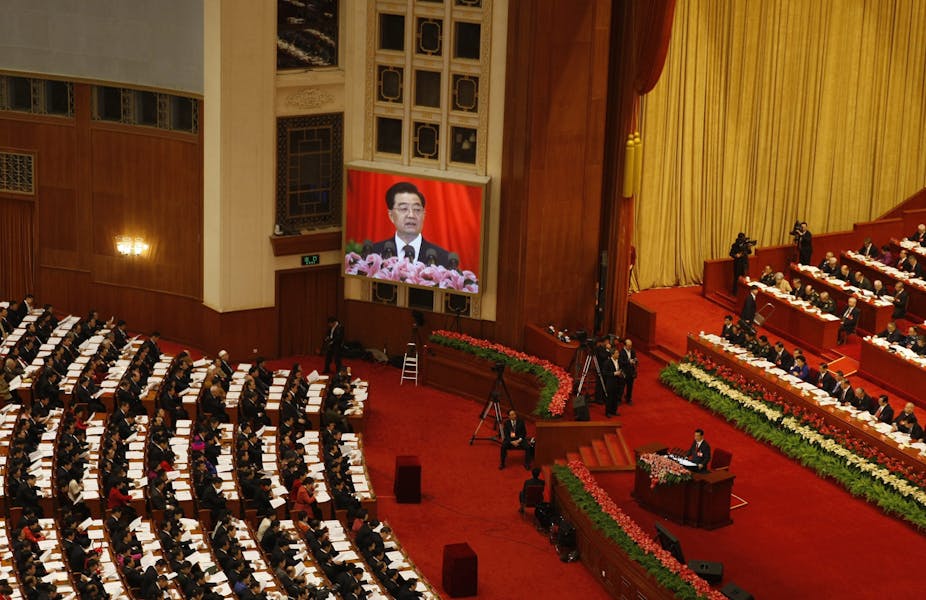CHINA IN TRANSITION: As China goes through its secretive but widely anticipated leadership transition, the rest of the world is watching. This week, The Conversation takes an in depth look at the National Congress of the Communist Party of China.
The 18th National Congress of the Communist Party of China and the expected inauguration of Xi Jinping is a curiosity from afar.
During the congress, taxis in Beijing have been told to keep passengers from rolling down windows to prevent the distribution of protest materials. Street vendors are not permitted during this period. There are reports kites have been banned.
Seemingly, over the past six decades the Communist Party has continued to be the legitimate single party that governs mainland China, a feat which raises the question: how has this been accomplished?
There are potentially five reasons to explain the party’s resilience, which gives us insight into not only party behaviour, but also the potential for political reforms that the West has long hoped for.
The first reason for the party’s resilience is an intuitive one: a result of repression. The regime has used repression as a means to suppress political dissent and decreasing rights and freedoms in the name of social stability. Since market reforms in 1978, repression, although still present, has declined sharply.
For instance, there were fewer political prisoners after the Tiananmen Square protests than at the end of the Cultural Revolution in 1976. This decline, coupled with modest improvement in rights and freedoms, reduces the argument to some extent that the Communist Party’s regime resilience is solely the result of massive repression.
Another theory is that the Communist regime survives because it is able to manage elites well. The 83 million members of the Communist Party, accounting for 6% of the country’s population, are rewarded for their loyalty with access to influence in various aspects of political, economic and social life. The nine active members of the Politburo Standing Committee (which is rumoured to be reduced to seven), and the 2,270 delegates of the National People’s Congress who forge an even further elite cohort are managed through closed-door dialogues and compromises, and are represented in the public under the guise of little to no dissent.
In this setup, it is easy to suggest that the larger population does not matter – reinforcing the theory of mass repression. Whereas in the early stages of the party’s history, the masses were repressed during the “Great Leap Forward” and the “Great Proletariat Cultural Revolution”; following the events of Tiananmen Square in 1989, we see the party were graphically reminded that the mass citizenry mattered.
In fact, the increased maturity of the present-day Communist Party lies in the fact that it pays close attention to popular attitudes. In this vein, the third theory suggests that the party’s ability to monitor popular sentiment, via methods such as using secretive opinion polls, monitoring rumours, and anti-regime thoughts on the internet, and even attempts to control internet usage and traffic via the “Great Fire Wall”, have proven to be useful regime.
The fourth theory suggests that the party survives because it is able to maintain popular legitimacy via its social compact with society. The modern social compact is performance-based, and founded on economic grounds. Crudely put, in the words of former leader Deng Xiaoping, “to get rich is glorious”. In post-reform China, the state encourages (via laws, regulations and slogans) both the elites and masses to pursue increasing their wealth portfolio.

If both groups continue to increase their wealth, then the legitimacy of the party is maintained. With robust growth in the economy, the resilience of the Chinese Communist Party lies in its ability to deliver economic prosperity to the majority of its citizens.
Embedded within the present social compact is the party’s ability to adapt and reuse political strategies of the past. While no longer on the propaganda trail of history, recent Chinese leadership has shown that it can still drum up intense domestic support by exploiting external situations.
For example, by fostering anti-Japanese sentiments over the Diaoyu Islands it has generated national support and a degree of certainty amongst the masses that the party is the one body that ensures stability in the present and future. The final theory thus suggests that such political strategies play a role in ensuring the endurance of the Communist Party.
The current Communist Party’s resilience suggests China may not see any meaningful political institutional changes in the near future, in spite of a new Xi Jinping administration. Nevertheless, the new administration will have to show an increased commitment to improve the livelihoods of those who do not benefit from the current social compact. Against this background, there are a growing number of Chinese citizens who have not achieved higher incomes, and have experienced reduce social services.
The redistributive commitments of the central state may have to increase in order to ensure the future of its regime. In this sense, if in no other, there is shared ground with the recent election in the US: economic rejuvenation is the key to success.

